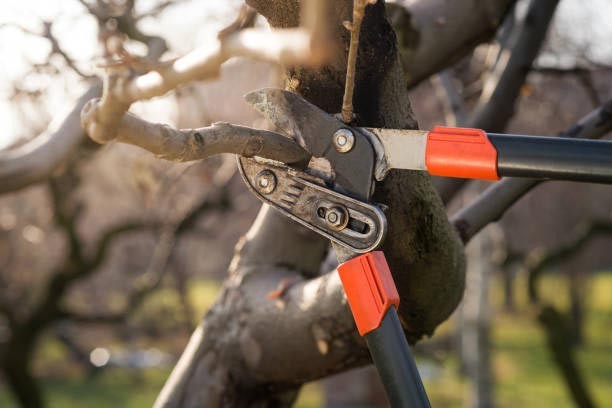Tree pruning requires good understanding of trees/shrubs, there is an article on the book called “The HomeOwners complete Tree and Shrub Handbook” by “Penelope O’Sullivan”.
 Find the article below:
Find the article below:Until you understand it’s simple logic, pruning can be one of gardening’s great mysteries. Pruning plants for the right reasons with the tight tools at the right time and in the right places on the plant can make both your plants and the landscape that surrounds them more refined and more beautiful. There are many reasons for prune, and all of them make good sense.
Healthier,more vital plants. Cut off dead or diseased branches not only to improve a plants appearance, but also to prevent the spread of disease. Remove crossing and rubbing branches, a condition that can wear away protective bark, compromising the plants health, Prune back limbs damaged by ice, heavy wet snow, strong winds, or mechanical damage. In some cases, you may have to remove whole plants, while in others only damaged areas need cutting.
Beauty. Good pruning can show off or even improve the basic form or structure of the plant.
Safety. If a low branch extends over a path, you may need to remove it to prevent tripping. Phone the power company if high limbs interfere with power lines Prune back bushy plants growing near a road or at corners where the plants may block a driver’s line of vision on the road or emerging from a driveway.
Tender-Loving Tool Care:
Whatever tools you choose, keep them clean since dirty blades can spread pests and infections from pants to plants. Disinfect cutting surfaces with rubbing alcohol applied to a clean rag or paper towel. Tuck a fresh rag in your belt for wiping dirt and sap from the blades before each cut.
When necessary, follow the manufacturer’s directions for taking apart pruners and saws. Remove rust from blades with fine sandpaper or a wire brush. Oil joints and springs regularly, and use a sharpening stone to hone the outer beveled edge of dull blades. Taking healthy cuts that benefit rather than damage the tree.

Pruning a Branch:
Dr. Alex Shigo, former chief scientist in the U.S. Forest Service, discusses natural target pruning in his book Modern Arboriculture. He recommends that proper pruning cuts he made close to the branch collar the bulge under a branch where branch and stem tissues intersect) not flush with the trunk. Unlike humans, who heal by renewing injured tissue, trees compartmentalize, or close off, an injury from the rest of the tree by forming new wood over the damaged spot. Flush cuts that take off the branch collar enlarge the wound and spread more decay within the tree.
Let pruning wounds heal naturally. Don’t paint them with wound dressing; dressings slow the healing process and keep the healthy new wood from forming
Trees look their best when natural growth patterns guide your pruning efforts. Don’t top trees. Topping is the practice of cutting back, or “heading,” a tree’s large branches, leaving long, ugly stubs from which many weak sprouts will grow. Topping destroys a tree’s looks and makes it prone to disease and decay. It’s better to remove a too-big tree, replacing it with one that suits the site, than to take this drastic and mistaken measure to
control tree growth. The drawings below (The Three-Part Cut) illustrate the technique for pruning off any branches that are at least 11/2 inches in diameter.
Timing your Pruning:
Among the factors that determines the best time to prune woodies are why you’re growing them and when they bloom. Did you plant them for lush leaves, lavish flowers , or luscious fruits?. Do they bloom in winter, spring, summer. Or fall?. And when do they form flower buds on their branches.
Basic Pruning guidelines:
Pruning deciduous trees and shrubs during late fall and winter dormancy helps limit contact with insects and fungi, which tend to be more active in warm weather, Dormant – pruning plants in the rose family helps prevent fireblight but may affect that years flowers. Pruning when the trees are bare also allows you to see the shape of the tree.
Flowering Trees and shrubs:
The general rule is to prune flowering shrubs and trees that bloom on new wood ( the current growth ) in late winter or early spring before the start of this season growth Prune those that bloom on old wood (Stem developed before the current growing season ) soon after flowering to avoid removing this year’s blossoms.
Problematic Branches : You can remove dead. Damaged, or diseased branches anytime. It’s best to remove crossed or rubbing branches when dormant, especially if they ruin the plants structural appeal by making it look congested. Many shrubs need little pruning beyond that.
 If you’re busy, you may not have much choice about when to prune: you just prune when you have free time. That’s okay even for flowering trees and shrubs. If you don’t mind sacrificing one season’s flowers. By selectively pruning shrubs blooming on old wood soon before they bloom. You’ll give up some flowers. But if, for example, you clip a lilac hedge in late summer after it has set buds for the following spring you may be cutting off all the flowers.
If you’re busy, you may not have much choice about when to prune: you just prune when you have free time. That’s okay even for flowering trees and shrubs. If you don’t mind sacrificing one season’s flowers. By selectively pruning shrubs blooming on old wood soon before they bloom. You’ll give up some flowers. But if, for example, you clip a lilac hedge in late summer after it has set buds for the following spring you may be cutting off all the flowers.
